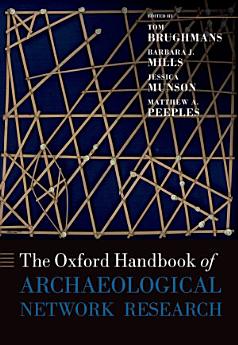The Oxford Handbook of Archaeological Network Research
Tom Brughmans · Barbara J. Mills · Jessica Munson · Matthew A. Peeples
Nov 2023 · Oxford University Press
Ebook
736
Pages
family_home
Eligible
info
reportRatings and reviews aren’t verified Learn More
About this ebook
Network research has recently been adopted as one of the tools of the trade in archaeology, used to study a wide range of topics: interactions between island communities, movements through urban spaces, visibility in past landscapes, material culture similarity, exchange, and much more. This Handbook is the first authoritative reference work for archaeological network research, featuring current topical trends and covering the archaeological application of network methods and theories. This is elaborately demonstrated through substantive topics and case studies drawn from a breadth of periods and cultures in world archaeology. It highlights and further develops the unique contributions made by archaeological research to network science, especially concerning the development of spatial and material culture network methods and approaches to studying long-term network change. This is the go-to resource for students and scholars wishing to explore how network science can be applied in archaeology through an up-to-date overview of the field.
About the author
Tom Brughmans is an associate professor at Aarhus University's Classical Archaeology and Centre for Urban Network Evolutions (UrbNet). His research interests include the study of past social networks, Roman ceramics, citation networks and visual signalling systems. He performs much of his work by applying computational methods such as network science, agent-based simulation and geographical information systems. He leads the Past Social Networks Project, which aims to encourage the open publication and reuse of past social network data, through developing a dedicated repository and metadata standards. Barbara J. Mills is Regents Professor of Anthropology at the School of Anthropology, University of Arizona. She has edited or authored eight books and monographs, and dozens of articles and chapters in books, including "The Establishment and Defeat of Hierarchy: Inalienable Possessions and the History of Collective Prestige Structures in the Puebloan Southwest" (2004, American Anthropologist), winner of the Gordon Willey Award. Jessica Munson is Associate Professor of Archaeology and Anthropology at Lycoming College. Her research combines archaeological fieldwork with quantitative studies of settlement patterns, household possessions, and hieroglyphic inscriptions to investigate the long-term dynamics of sociopolitical systems and spread of cultural innovations across the Maya lowlands. She is also director of the Proyecto Arqueológico Altar de Sacrificios (PAALS), a multidisciplinary project that combines regional survey, household excavations, and paleoenvironmental studies to examine the diverse factors that contributed to the development of inequality and socioeconomic difference in ancient Maya society. Matthew A. Peeples Associate Professor of Anthropology in the School of Human Evolution and Social Change at Arizona State University, and Director of the ASU Center for Archaeology and Society. His research is focused on using network methods and models with archaeological data to address questions revolving around the nature of regional scale social networks over the long-term in the ancient US Southwest and Mexican Northwest. He serves as co-PI of cyberSW, a cyberinfrastructure project focused on providing archaeological data and open-access tools to analyze them to facilitate interdisciplinary social science research in the US Southwest.
Rate this ebook
Tell us what you think.
Reading information
Smartphones and tablets
Install the Google Play Books app for Android and iPad/iPhone. It syncs automatically with your account and allows you to read online or offline wherever you are.
Laptops and computers
You can listen to audiobooks purchased on Google Play using your computer's web browser.
eReaders and other devices
To read on e-ink devices like Kobo eReaders, you'll need to download a file and transfer it to your device. Follow the detailed Help Center instructions to transfer the files to supported eReaders.





